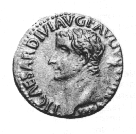
The Relationship between Rome and Judea prior to Jesus' public life
On August 19, 14 CE at 3:00 PM, Augustus Caesar dies, 35 days from his 76th birthday, at Nola in Campania. Tiberius becomes emperor.

Dupondis of Tiberius
Tiberius Claudius Nero was born in 42 B.C.E., the son of Tiberius Nero, Julius Caesar’s naval commander and hero of the Alexandrian War, and his wife Livia. Hounded and pursued by Octavian/Augustus and the triumvirs, Nero was constantly "on the run" as a result of his Republican convictions. As a result, the first 4 years of Tiberius life was one of great hardships. At the age of 4, Octavian forced his parents to divorce and married Livia. The heirs to Augustus’ throne were his grandsons, Gaius and Lucius, the children of his daughter Julia and Marcus Agrippa. When Agrippa died in 12 B.C.E., Augustus forced his stepson to divorce his beloved and pregnant wife Vipsania to marry his widowed daughter Julia. By 4 CE, both Gaius and Lucius had died and Augustus adopted Tiberius.
26 CE
Much could be written about the peculiar personality of Tiberius Caesar. New Testament History, however, would be most impacted by the rise to power, under Tiberius, of one of the most machiavellian schemers in history, Lucius Aelius Sejanus, prefect of the Praetorian Guard. Early in the year, the brooding Tiberius secluded himself in the Villa of Jupiter in the Island of Capreae (Capris), never again to set foot on the mainland. Sejanus himself, certainly had much to do with the Emperor’s seclusion, feeding his suspicions and paranoia over life in Rome. Tiberius continued to govern from Capris but for all practical purposes the power hungry Sejanus was running the empire. All access and correspondence to the emperor went through Sejanus who was the perfect Roman Svengali to Tiberius’ Trilby. Sejanus’ appointments, probably rubber-stamped by Tiberius, were drawn from his greedy and corrupt associates. One of these appointments was the 5th prefect of Judea, Samaria, and Idumea, Pontius Pilatus.
Pontius Pilatus becomes Prefect of Judea.
A son of an eminent Roman equestrian family, Pontius Pilatus, "Pilate," would have had the usual diplomatic and military training reserved for this rank of Roman aristocracy. Pontius is a gens nomen (clan name) of Samnite origin and the family name Pilatus derives from pilum, meaning "spear." His praenomen is not preserved. He probably went through a number of minor functionary posts under Tiberius. His appointment to the prefecture of Judea in 26 CE suggests that he was close to Sejanus. His character certainly fits the corrupt thugs who were the cronies of Tiberius’ lieutenant. He was married to Claudia Procula, the granddaughter of the Emperor Augustus and the illegitimate daughter of Tiberius’ third wife Claudia. This certainly suggests that Pilate was close to the Roman court. Pilate was not diplomat material. He was arrogant, proud, hot-tempered, cruel and obstinate. An educated speculation of the circumstances would be that the marriage was arranged by Sejanus and the appointment to Judea came through his marriage to the sensitive and sophisticated princess. The wives of Roman diplomats were normally not allowed to accompany their husbands. Most preferred the comfort and social life of Rome rather than the discomfort and dangers of the Roman provinces. We know, however, that Claudia accompanied Pilate to Judea. This suggests permission from her stepfather, Tiberius, and that she must have genuinely loved Pilate. Pilate would have been about the same age as Jesus when he arrived in Judea in the latter part of 26 CE.
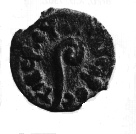
Coin issued by Pilate during the public ministry of Jesus
Pilate’s first act, almost as soon as his sandals were dusted with Judean soil, was to march into Jerusalem carrying images of the emperor on his standards. The standards of Roman legionaries were religious icons, in this case the imperial cult. Sacrifices were made to these standards both in preparation and in triumph. This practice is mentioned, with some hostility, in the Dead Sea Scrolls. This action by Pilate was in contradiction to Augustus’ orders granting Jerusalem immunity from these images. Pilate had the images mounted on the walls of the Fortress Antonia facing the Temple. I don’t know whether this was an act of deliberate provocation or simply Pilate’s ignorance about Jews and Augustus’ edict. The fact that he did it at night suggests to me that he was aware of the implications. He may not have anticipated the intensity of the Jewish reaction. Scholars debate whether or not Pilatus was anti-Jewish. Philo reports that Sejanus was and Pilate could certainly have been mimicking his patron and crony. The accuracy of Philo’s account also has been considered by some as inaccurate and his polemic against Pilate purely political. I find it hard to believe that a man whose cruelty, provocation and executions of thousands of Jews depicts anything else. Retiring to his headquarters in Caesarea, Pilate had prepared legionnaires to attack and kill any Jews that tried to storm the fortress over the images. Instead, some 7,000 Jews marched to Caesarea and picketed Pilate’s residence. He refused to talk to any deputation and the picketing continued for a week. Unnerved, Pilate finally agreed to talk to them in the Agora, having prepared his soldiers to butcher the entire gathering. As the soldiers surrounded the marketplace, the Jews all knelt in prayer, preferring to die rather than suffering the hated icons in view of the Temple. Pilate relented and had the icons removed. This first act of provocation ended in humiliation for Pilate and almost certainly set the tone of his manner in handling Jewish affairs.
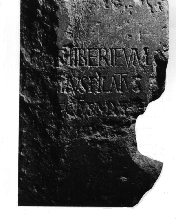
Inscription placed by Pilatus on the Roman theater in Caesarea
dedicated to Tiberius Caesar
Pilate’s relationship with Caiaphas.
Joseph Caiaphas (Yosef bar Qof) had been appointed High Priest under the procuratorship of Valerius Gratus in 18 CE. It is significant to me that he served in this capacity for 18 years until 36 CE. when Pilate himself was recalled, coinciding with the downfall and trial of Sejanus. High Priests came and went like the husbands of some movie stars, rarely serving more than 3 years. Caiaphas had probably worked out a good relationship with Valerius Gratus, Pilate’s predecessor, who himself served for eleven years in contrast to the normal 3 year terms of service. I do not believe that it is a coincidence that the unprecedented long terms of Gratus, Pilatus and Caiaphas coincide with the career of Lucius Aelias Sejanus. Judea may not have been considered a "plum" appointment because of the harsh surroundings but the opportunity for accumulating fortunes from graft and corruption was high. It is obvious that Caiaphas was "their man" in the Temple with access to the treasury as head of the party of the Sadducees and to all of the ancillary trade and commercial enterprises that surrounded the Temple. There were somewhere between 300,000 to 400,000 pilgrims in Jerusalem and surrounding areas for the temple services of Passover, eachcarrying a purse. Money changing, the selling of sacrificial animals, the money coming to the treasury from Jews all over the Roman world and hundreds of enterprises associated with the Temple were all being siphoned to enrich Sejanus, the prefect and the High Priest and his Sadducee cronies beyond the dreams of avarice. When Jesus entered the Temple early in the year 30 and condemned these practices, overturning money changers’ tables, it sealed his death warrant. Joseph Caiaphas, as High Priest and head of the collaborating Sadducees, who controlled these commercial enterprises, had a great thing going for himself and his Roman cronies, Gratus and Sejanus in Rome and later Pilatus and Sejanus.
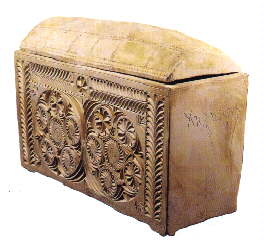
The ossuary containing the bones of Joseph Caiaphas
John the Baptist 8 B.C.E-28 CE
Any history of the New Testament event cannot discuss the launching of Jesus’ ministry without first discussing Yohanon bar Zechariya, who was called Yohanon b’Madbera, John the Baptizer. The figure of John looms over the emerging Jesus, capturing the imaginations of historians, scholars, and novelists from the first century to the present day. The historicity of John the Baptist is not questioned by scholars. I accept two extracanonical sources for attestation of John; Josephus and the Gospel of Thomas. Josephus’ account is used by Eusebius and Origen in the 2nd and 3rd centuries. Unlike some scholars, I consider the Gospel of Thomas an independent tradition from the Gospels. John is treated in all four Gospels, some dependent on the other, however there seems to be three independent sources for the Gospel witness of John in Mark, Q, and the M source of Matthew. That John is historical, few scholars would argue. His exact relationship to Jesus is another matter. According to Luke, John was born to an elderly couple. John’s father, Zechariya was, according to Luke, a priest of the course of Abija, one of the 24 divisions of priests who served the Temple. His mother Elizabeth was also descended from Aaron. Women descended from a priestly family were expected to marry priests. Each division of priests served at the Temple for one week every 6 months. During that week, four lots would be cast every morning to grant the winners the privilege of four tasks: serving for the burnt animal offering; the meal offering; offering incense; and maintaining the candlestick in the Holy Place. The offering of incense was a singular and great privilege which could not be repeated until all priests of that particular division had served. Since there were probably 5,000 priests in the course of Abija with only 14 priests per year winning the privilege, it was a rare honor. The offering of the incense was the only one of the four tasks performed in the afternoon at the 9th hour (3PM). This task consisted of entering the sanctuary, taking incense from a bowl and placing it on burning coals. The incense wafting from the Temple and the blowing of the shofar was a call to prayer. It should be noted that this prayer time at the Temple was, according to Matthew 27:45-51, the exact time of Jesus’ death when the curtain of the Temple was rent in two. Whether this crowded and busy time of prayer and offering was chosen symbolically by the author of Matthew as the "supreme offering" (thereby entering our previously mentioned theologoumenon category) or was the actual time of Jesus’ death, is a matter of speculation.
John, like Jesus, appears on the scene at age 30 with no record of his previous life except that he "came from the wilderness." Luke reports "and the child grew, and waxed strong in spirit, and was in the deserts till the day of his shewing unto Israel." Since it is not likely that a child grew up in the desert, a common metaphor for the area of Qumran, many scholars believe that John may have been raised by the sectarians at Qumran, it being a practice of the celibate sectarians (although probably not all Essenes) to adopt and raise children in "the Way."
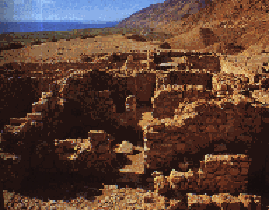
Qumran
The gospel accounts are in general agreement with that of Josephus and supply separate witnesses to the historicity of John. These accounts have John coming out of the Judaean "desert" (Qumran?) to establish his "kingdom movement" and to call for repentance and is reminiscent of the Rule of the Community 1QS (Serekh ha-Yahad) and the Manual of Discipline 8:13-15: "…From the dwelling place of the men of perversion in order to go to the wilderness to prepare the way of HIM, as it is written, In the wilderness prepare the way of ****, make straight in the desert a road for our God." The most probable historical context for John the Baptist is that he emerged from the Qumran Community to carry the message of the coming Kingdom of God and to call for baptism and repentance. This would have been a point of difference with his sectarian mentors who considered themselves a separate elite. John’s ministry was separate and independent of Jesus. He probably met Jesus only once when Jesus himself showed his reverence for John by submitting to baptism, perhaps being a disciple of John himself for a brief period. After John’s death at the hands of Herod Antipas, he left a large following who continued to exist apart from the Yeshuines. The emergence of Apollos around 50 CE as a follower of the "Baptism of John" is witness to the movement of John in Egypt in the mid first century. Was John the Baptist more "famous," more revered by the Jewish population than Jesus at the time of their mutual ministries? Perhaps. Evidence of this may lie in the separate accounts of Jesus and John in Josephus. The Josephan account of Jesus was originally very short and fell between the account of Pontius Pilate’s attack on Jews protesting the building of the aqueduct and of Paulina. It was such a cursory treatment that later Christian publishers interpolated and expanded it with non-Josephan christology. The account of John the Baptist is lengthier, more laudatory and remains in Josephan style. Josephus makes no mention of a connection between Jesus and John. Jesus submission to baptism by John and the likelihood that he was briefly a disciple of John before beginning his own "kingdom movement" may have been perceived as an embarassment to the Gospel authors. The had to "deal with" John, perhaps as a mechanism for bringing the followers of John into the Jesus movement. Luke uses an early pre-Gospel tradition of an angelic annunciation of Jesus’ birth to compose a similar scenario for John. He also presents John as a relative of Jesus for which there is no other independent witness. In fact, a pericope from the first stratum of John, an earlier witness than Luke, contradicts a relationship. I believe the blood relationship between Jesus and John to be fictional and a device used to "deal" with John by the Gospel authors. There are those who believe there was a separate pre-Gospel John tradition in Aramaic. The Jesus infancy narrative may have been "lifted" from that earlier John tradition. The John infancy narrative in Luke, beginning at Luke 1:5, and the Jesus narrative, beginning with Luke 2:1 preface the original beginning of "proto-Luke" at chapter 3. Both are very Hebraic and were apparently prefaced from Aramaic sources at the time of the final redaction of Luke around 85 CE. The relationship between the Jesus and John traditions is presented in great detail by Brown, Birth of the Messiah. Meier, in A Marginal Jew, treats the issue for over 200 pages prior to his excellent exposition of the "Kingdom Movement." If John the Baptist and Jesus had little personal contact in life, they certainly were related eschatologically and, as a result, became closely entwined in tradition.